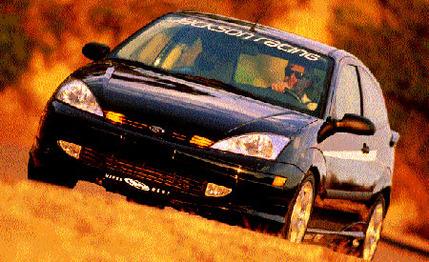
 Specialty File
Specialty File
As a rule of thumb, the worth of a tuner car (TC) is inversely proportional to the square of the size of the entourage (E) assigned to accompany it during a test, multiplied by the inherent goodness of the unmolested stock vehicle (SV). So using the TC = SV/E2 formula, a modified machine that shows up with two minders is only a quarter as good as a car that shows up with one-and a tuner car with four attendants is undrivable. Jackson Racing gave us its supercharged Ford Focus ZX3 and told us to bring it back whenever we were done. That's zero people attached to it. What good is a rule of thumb that has lost its denominator?
At 47, Oscar Jackson is twice the age of many small-car tuners. He started pounding on Hondas back when the hot tip was stuffing high-compression Gold Wing motorcycle pistons under the early Civics' CVCC cylinder head. Since the mid-'90s, he's concentrated on supercharger systems for four-cylinder Hondas and Acuras, the Mazda Miata, and now, Ford's Focus ZX3. Not surprisingly, the goals of this graybeard of tuning are more mature than the nihilistic bombast of teen tweakers.


The heart of Jackson's kit is the Eaton supercharger-the same Roots-type blower used on vehicles ranging from the Mercedes SLK230 to the Ford SVT F-150 Lightning and Jaguar XJR. For the Focus, Jackson bolts the smallest 45-cubic-inch version of the twin-rotor Eaton to the 2.0-liter DOHC 16-valve Zetec four. The supercharger whirs at 1.73 times engine speed and has an integral bypass valve that allows a modest 6.0 pounds of boost. Jackson's intent isn't to transform the Focus into a hyperactive racing machine (despite all those stickers) but to expand performance in daily driving.
Sitting between the fire wall and engine block, the supercharger breathes in through the stock throttle body, air-mass sensor, and air filter and blows out into a specially cast manifold. Jackson's car also carries parts-maker Focus Sport's "shorty" headers ($349) that, whether they're effective at freeing up power or not, look sweet. They in turn feed the stock catalytic converter and a Focus Sport stainless steel exhaust ($600). If it weren't for the supplemental electronic fuel controller hook-and-looped to the battery cover, the whole installation would look as if it were done by Ford itself.


According to Jackson, a stock Focus ZX3 peaks at 103.4 horsepower and 110.7 pound-feet of torque on their Dynojet chassis dynamometer (Ford claims 130 horsepower and 135 pound-feet for the Zetec four at the flywheel). With the supercharger, headers, and exhaust, Jackson's tests show 150.2 horsepower and 129.5 pound-feet at the wheels with the power peak coming near the engine's 7000-rpm redline rather than at 5300 rpm, what Ford claims (and the Jackson test confirms) for the stock ZX3.
Turning 205/45VR-16 Yokohama A520 tires 0.9 inch shorter in diameter than stock ZX3 205/50VR-16 Goodyear RS-A rubber, the supercharged Focus got to 60 mph in 8.4 seconds (as opposed to 9.1 seconds for a stock ZX3 tested the same day) and dashed off the quarter-mile in 16.6 seconds at 84 mph (the stocker went 16.9 at 81 mph). More impressive, the 30-to-50-mph performance improved from the stock 15.0 seconds to 11.1, and the 50-to-70-mph performance drops from 13.8 to 12.7 seconds. That's quicker, but hardly the sort of bump expected of a 47-hp gain in a lightweight car, and it can't quite match the performance of Ford's own recently introduced 170-hp, six-speed SVT Focus, which bolts to 60 mph in 7.8 seconds, runs the quarter in 16.1 seconds at 87 mph, and takes 11.2 seconds to get from 30 to 50 mph.
Since the Jackson car was a stripped-down ZX3-no power windows or mirrors, no sunroof-and the stock ZX3 brought along for comparison was loaded (for a Focus), the difference in weight between the two was slight, despite the Jackson car's $529 Wings West body kit. Explaining the performance differential therefore comes down to the shape of the power curve. The supercharger does a good job of improving top-end power but doesn't do much at the bottom end of the rev range where the grunt work of initial acceleration is done. In fact the 0-to-30-mph time for the stock and supercharged cars was the same at 2.7 seconds.
During throttle changes there's a slight whoosh from the bypass valve, but the supercharger itself is barely audible. There's no sensation of throttle lag, no clatter of detonation, and it started and ran without a hiccup-none of these is a common trait in Tunerland.
Forget missing denominators, the math that matters here is how the supercharged ZX3 stacks up against the SVT Focus. Jackson's Focus is lowered 1.25 inches with a set of its own sport springs ($219), treated to a set of Koni adjustable shocks ($872), and mounted on those A520s with TSW wheels ($1196). The lowering saps some compliance out of the Jackson car's suspension, and although the Focus's inherent balance remains, the quicker SVT, which rides on 17-inch wheels and tires, has a significantly more refined and capable chassis.
The supercharger system goes for $3295 (from Jackson or Ford Racing), and adding in the header, exhaust, springs, shocks, wheels, body kit, and tires pushes the tab beyond $7000-assuming zero installation cost. Ultimately, the SVT's $17,995 base price makes it a performance bargain that can't be beat with a supercharger installation.
And that's why Jackson's blower for the SVT Focus should be ready any moment.
Jackson Racing, 440 Rutherford Street, Goleta, California 93117; 888-888-4079; www.jacksonracing.com.